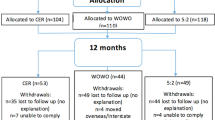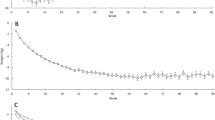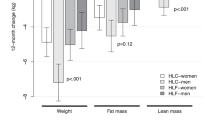Abstract
Background/Objectives:
Controlling food portion sizes can help reduce energy intake, but the effect of different portion-control methods on weight management is not known. In a 1-year randomized trial, we tested whether the efficacy of a behavioral weight-loss program was improved by incorporating either of the two portion-control strategies instead of standard advice about eating less.
Subjects/Methods:
The Portion-Control Strategies Trial included 186 women with obesity (81%) or overweight (19%). Participants were randomly assigned to one of three equally intensive behavioral programs, consisting of 19 individual sessions over 12 months. The Standard Advice Group was instructed to eat less food while making healthy choices, the Portion Selection Group was instructed to choose portions based on the energy density using tools such as food scales and the Pre-portioned Foods Group was instructed to structure meals around pre-portioned foods such as single-serving main dishes, for which some vouchers were provided. In an intention-to-treat analysis, a mixed-effects model compared weight loss trajectories across 23 measurements; at month 12, weight was measured for 151 participants (81%).
Results:
The trajectories showed that the Pre-portioned Foods Group initially lost weight at a greater rate than the other two groups (P=0.021), but subsequently regained weight at a greater rate (P=0.0005). As a result, weight loss did not differ significantly across groups at month 6 (mean±s.e. 5.2±0.4 kg) or month 12 (4.5±0.5 kg). After 1 year, measured weight loss averaged 6% of baseline weight. The frequency of using portion-control strategies initially differed across groups, then declined over time and converged at months 6 and 12.
Conclusions:
Incorporating instruction on portion-control strategies within a 1-year behavioral program did not lead to a greater weight loss than standard advice. Using pre-portioned foods enhanced early weight loss, but this was not sustained over time. Long-term maintenance of behavioral strategies to manage portions remains a challenge.
This is a preview of subscription content, access via your institution
Access options
Subscribe to this journal
Receive 12 print issues and online access
$259.00 per year
only $21.58 per issue
Buy this article
- Purchase on Springer Link
- Instant access to full article PDF
Prices may be subject to local taxes which are calculated during checkout



Similar content being viewed by others
References
Nielsen SJ, Popkin BM . Patterns and trends in food portion sizes, 1977-1998. J Am Med Assoc 2003; 289: 450–453.
Young LR, Nestle M . The contribution of expanding portion sizes to the U.S. obesity epidemic. Am J Public Health 2002; 92: 246–249.
Smiciklas-Wright H, Mitchell DC, Mickle SJ, Goldman JD, Cook A . Foods commonly eaten in the United States, 1989-1991 and 1994-1996: are the portion sizes changing? J Am Diet Assoc 2003; 103: 41–47.
Rolls BJ, Morris EL, Roe LS . Portion size of food affects energy intake in normal-weight and overweight men and women. Am J Clin Nutr 2002; 76: 1207–1213.
Rolls BJ, Roe LS, Meengs JS . The effect of large portion sizes on energy intake is sustained for 11 days. Obesity 2007; 15: 1535–1543.
Kral TVE, Roe LS, Rolls BJ . Combined effects of energy density and portion size on energy intake in women. Am J Clin Nutr 2004; 79: 962–968.
English L, Lasschuijt M, Keller KL . Mechanisms of the portion size effect. What is known and where do we go from here? Appetite 2015; 88: 39–49.
Herman CP, Polivy J, Pliner P, Vartanian LR . Mechanisms underlying the portion-size effect. Physiol Behav 2015; 144: 129–136.
Livingstone MBE, Pourshahidi LK . Portion size and obesity. Adv Nutr 2014; 5: 829–834.
US Department of Agriculture and US Department of Health and Human Services. Dietary Guidelines for Americans, 2010, 7th edn, US Government Printing Office: Washington, DC, USA, 2010.
Raynor HA, Champagne CM . Position of the Academy of Nutrition and Dietetics: interventions for the treatment of overweight and obesity in adults. J Acad Nutr Diet 2016; 116: 129–147.
Rolls BJ . What is the role of portion control in weight management? Int J Obes 2014; 38: S1–S8.
Ello-Martin JA, Roe LS, Ledikwe JH, Beach AM, Rolls BJ . Dietary energy density in the treatment of obesity: a year-long trial comparing 2 weight-loss diets. Am J Clin Nutr 2007; 85: 1465–1477.
Ledikwe JH, Rolls BJ, Smiciklas-Wright H, Mitchell DC, Ard JD, Champagne C et al. Reductions in dietary energy density are associated with weight loss in overweight and obese participants in the PREMIER trial. Am J Clin Nutr 2007; 85: 1212–1221.
Raynor HA, Van Walleghen EL, Bachman JL, Looney SM, Phelan S, Wing RR . Dietary energy density and successful weight loss maintenance. Eat Behav 2011; 12: 119–125.
Rolls BJ . The relationship between dietary energy density and energy intake. Physiol Behav 2009; 97: 609–615.
Pérez-Escamilla R, Obbagy JE, Altman JM, Essery EV, McGrane MM, Wong YP et al. Dietary energy density and body weight in adults and children: a systematic review. J Acad Nutr Diet 2012; 112: 671–684.
Byrd-Bredbenner C, Schwartz J . The effect of practical portion size measurement aids on the accuracy of portion size estimates made by young adults. J Hum Nutr Diet 2004; 17: 351–357.
Faulkner GP, Livingstone MB, Pourshahidi LK, Spence M, Dean M, O'Brien S et al. An evaluation of portion size estimation aids: precision, ease of use and likelihood of future use. Public Health Nutr 2016; 19: 2377–2387.
Pedersen SD, Kang J, Kline GA . Portion control plate for weight loss in obese patients with type 2 diabetes mellitus: a controlled clinical trial. Arch Intern Med 2007; 167: 1277–1283.
Kesman RL, Ebbert JO, Harris KI, Schroeder DR . Portion control for the treatment of obesity in the primary care setting. BMC Res Notes 2011; 4: 346.
Huber JM, Shapiro JS, Wieland ML, Croghan IT, Vickers Douglas KS, Schroeder DR et al. Telecoaching plus a portion control plate for weight care management: a randomized trial. Trials 2015; 16: 323.
Rolls BJ, Roe LS, Beach AM, Kris-Etherton PM . Provision of foods differing in energy density affects long-term weight loss. Obes Res 2005; 13: 1052–1060.
Wing RR, Jeffery RW, Burton LR, Thorson C, Nissinoff KS, Baxter JE . Food provision vs structured meal plans in the behavioral treatment of obesity. Int J Obes Relat Metab Disord 1996; 20: 56–62.
Wing RR, Jeffery RW . Food provision as a strategy to promote weight loss. Obes Res 2001; 9: 271S–275S.
Heymsfield SB . Meal replacements and energy balance. Physiol Behav 2010; 100: 90–94.
European Food Safety Authority, Panel on Dietetic Products, Nutrition and Allergies, (NDA). Scientific opinion on the substantiation of health claims related to meal replacements for weight control (as defined in Directive 96/8/EC on energy restricted diets for weight loss) and reduction in body weight (ID 1417), and maintenance of body weight after weight loss (ID 1418) pursuant to Article 13(1) of Regulation (EC) No 1924/2006. EFSA J 2010; 8, 1466 [19 pp.].
Hannum SM, Carson LA, Evans EM, Canene KA, Petr EL, Bui L et al. Use of portion-controlled entrees enhances weight loss in women. Obes Res 2004; 12: 538–546.
Hannum SM, Carson LA, Evans EM, Petr EL, Wharton CM, Bui L et al. Use of packaged entrees as part of a weight-loss diet in overweight men: an 8-week randomized clinical trial. Diabetes Obes Metab 2006; 8: 146–155.
Rock CL, Flatt SW, Pakiz B, Barkai HS, Heath DD, Krumhar KC . Randomized clinical trial of portion-controlled prepackaged foods to promote weight loss. Obesity 2016; 24: 1230–1237.
Garner DM, Olmsted MP, Bohr Y, Garfinkel PE . The Eating Attitudes Test: psychometric features and clinical correlates. Psychol Med 1982; 12: 871–878.
Beck AT, Steer RA, Brown GK . Manual for the Beck Depression Inventory-II. Psychological Corporation: San Antonio, TX, USA, 1996.
Littell RC, Milliken GA, Stroup WW, Wolfinger RD, Schabenberger O . SAS for Mixed Models. 2nd edn. SAS Institute, Inc.: Cary, NC, USA, 2006.
Rolls BJ . The Ultimate Volumetrics Diet: Smart, Simple, Science-Based Strategies for Losing Weight and Keeping It Off. William Morrow: New York, NY, USA, 2012.
National Center for Health Statistics, Centers for Disease Control and Prevention. National Health and Nutrition Examination Survey (NHANES): Anthropometry Procedures Manual. US Department of Health and Human Services: Hyattsville, MD, USA, 2011.
Hill NR, Levy JC, Matthews DR . Expansion of the homeostatic model assessment of β-cell function and insulin resistance to enable clinical trial outcome modeling through the interactive adjustment of physiology and treatment effects: iHOMA2. Diabetes Care 2013; 36: 2324–2330.
University of Minnesota (USA). Nutrition Data System for Research - Nutritional Analysis Software [Internet]. 2016 [cited 14 June 2016]. Available at http://license.umn.edu/technologies/ndsr87072_nutrition-data-system-for-research-nutritional-analysis-software.
Stunkard AJ, Messick S . The three-factor eating questionnaire to measure dietary restraint, disinhibition and hunger. J Psychosom Res 1985; 29: 71–83.
Ello-Martin JA . Reducing Dietary Energy Density for the Treatment of Obesity: The Long-Term Effects on Weight Loss, Hunger, and Diet Satisfaction [dissertation]. The Pennsylvania State Universit: University Park, PA, USA, 2006.
Institute of Medicine, Food and Nutrition Board. Dietary Reference Intakes for Energy, Carbohydrates, Fiber, Fat, Fatty Acids, Cholesterol, Protein, and Amino Acids. The National Academies Press: Washington, DC, USA, 2002.
Magkos F, Fraterrigo G, Yoshino J, Luecking C, Kirbach K, Kelly SC et al. Effects of moderate and subsequent progressive weight loss on metabolic function and adipose tissue biology in humans with obesity. Cell Metab 2016; 23: 591–601.
Appel LJ, Champagne CM, Harsha DW, Cooper LS, Obarzanek E, Elmer PJ et al. Effects of comprehensive lifestyle modification on blood pressure control: main results of the PREMIER clinical trial. J Am Med Assoc 2003; 289: 2083–2093.
Wing RR, Hamman RF, Bray GA, Delahanty L, Edelstein SL, Hill JO et al. Achieving weight and activity goals among Diabetes Prevention Program lifestyle participants. Obes Res 2004; 12: 1426–1434.
Poelman PP, de Vet E, Velema E, de Boer MR, Seidell JC, Steenhuis IHM . PortionControl@HOME: results of a randomized controlled trial evaluating the effect of a multi-component portion size intervention on portion control behavior and body mass index. Ann Behav Med 2015; 49: 18–28.
Marteau TM, Hollands GJ, Shemilt I, Jebb SA . Downsizing: policy options to reduce portion sizes to help tackle obesity. BMJ 2015; 351: h5863.
US Department of Health and Human Services, National Institutes of Health, National Institute of Diabetes and Digestive and Kidney Diseases. Just Enough for You. About Food Portions. US Government Printing Office: Washington, DC, USA, 2012.
US Department of Agriculture. ChooseMyPlate.gov website. Portion distortion. Available at https://www.choosemyplate.gov/tools-portion-distortion cited 26 September 2016.
Gibson AA, Hsu MS, Rangan AM, Seimon RV, Lee CM, Das A et al. Accuracy of hands v. household measures as portion size estimation aids. J Nutr Sci 2016; 5: e29.
Wharton CM, Johnston CS, Cunningham BK, Sterner D . Dietary self-monitoring, but not dietary quality, improves with use of smartphone app technology in an 8-week weight loss trial. J Nutr Educ Behav 2014; 46: 440–444.
Martin CK, Nicklas T, Gunturk B, Correa JB, Allen HR, Champagne C . Measuring food intake with digital photography. J Hum Nutr Diet 2014; 27 (Suppl. 1): 72–81.
Rouhani MH, Haghighatdoost F, Surkan PJ, Azadbakht L . Associations between dietary energy density and obesity: a systematic review and meta-analysis of observational studies. Nutrition 2016; 32: 1037–1047.
Stelmach-Mardas M, Rodacki T, Dobrowolska-Iwanek J, Brzozowska A, Walkowiak J, Wojtanowska-Krosniak A et al. Link between food energy density and body weight changes in obese adults. Nutrients 2016; 8: 229.
Lemon SC, Wang ML, Haughton CF, Estabrook DP, Frisard CF, Pagoto SL . Methodological quality of behavioural weight loss studies: a systematic review. Obes Rev 2016; 7: 636–644.
Dawson JA, Kaiser KA, Affuso O, Cutter GR, Allison DB . Rigorous control conditions diminish treatment effects in weight loss-randomized controlled trials. Int J Obes 2015; 40: 895–898.
Heymsfield SB, Harp JB, Reitman ML, Beetsch JW, Schoeller DA, Erondu N et al. Why do obese patients not lose more weight when treated with low-calorie diets? A mechanistic perspective. Am J Clin Nutr 2007; 85: 346–354.
Thomas DM, Martin CK, Redman LM, Heymsfield SB, Lettieri S, Levine JA et al. Effect of dietary adherence on the body weight plateau: a mathematical model incorporating intermittent compliance with energy intake prescription. Am J Clin Nutr 2014; 100: 787–795.
Finley CE, Barlow CE, LaMonte MJ, Greenway FL, Rock CL, Rolls BJ et al. Retention rates and weight loss in a commercial weight management program. Int J Obesity 2007; 31: 292–298.
Crino M, Sacks G, Vandevijvere S, Swinburn B, Neal B . The influence on population weight gain and obesity of the macronutrient composition and energy density of the food supply. Curr Obes Rep 2015; 4: 1–10.
Acknowledgements
This research was supported by the National Institute of Diabetes and Digestive and Kidney Diseases (R01DK059853). The use of the Clinical Research Center was supported by the National Center for Advancing Translational Sciences, National Institutes of Health (UL1TR000127). Food vouchers were provided by unrestricted gifts from ConAgra Foods, Inc. and Nestlé USA. The content is solely the responsibility of the authors and does not necessarily represent the official views of the funding bodies. We thank the participants in the Portion-Control Strategies Trial and the research team at Penn State, particularly interventionists Jennifer Meengs, Kitti Halverson, Cara Meehan and Amy Ciccarella. No funding body influenced the study design, collection and analysis of data, or decision to publish.
Author information
Authors and Affiliations
Corresponding author
Ethics declarations
Competing interests
BJR receives royalties from the sale of the Volumetrics books. The remaining authors declare no conflict of interest.
Additional information
Supplementary Information accompanies this paper on International Journal of Obesity website
Supplementary information
Rights and permissions
About this article
Cite this article
Rolls, B., Roe, L., James, B. et al. Does the incorporation of portion-control strategies in a behavioral program improve weight loss in a 1-year randomized controlled trial?. Int J Obes 41, 434–442 (2017). https://doi.org/10.1038/ijo.2016.217
Received:
Revised:
Accepted:
Published:
Issue Date:
DOI: https://doi.org/10.1038/ijo.2016.217
This article is cited by
-
Rationale and development of a manualised dietetic intervention for adults undergoing psychological treatment for an eating disorder
Eating and Weight Disorders - Studies on Anorexia, Bulimia and Obesity (2021)
-
Health, pleasure, and fullness: changing mindset affects brain responses and portion size selection in adults with overweight and obesity
International Journal of Obesity (2020)



